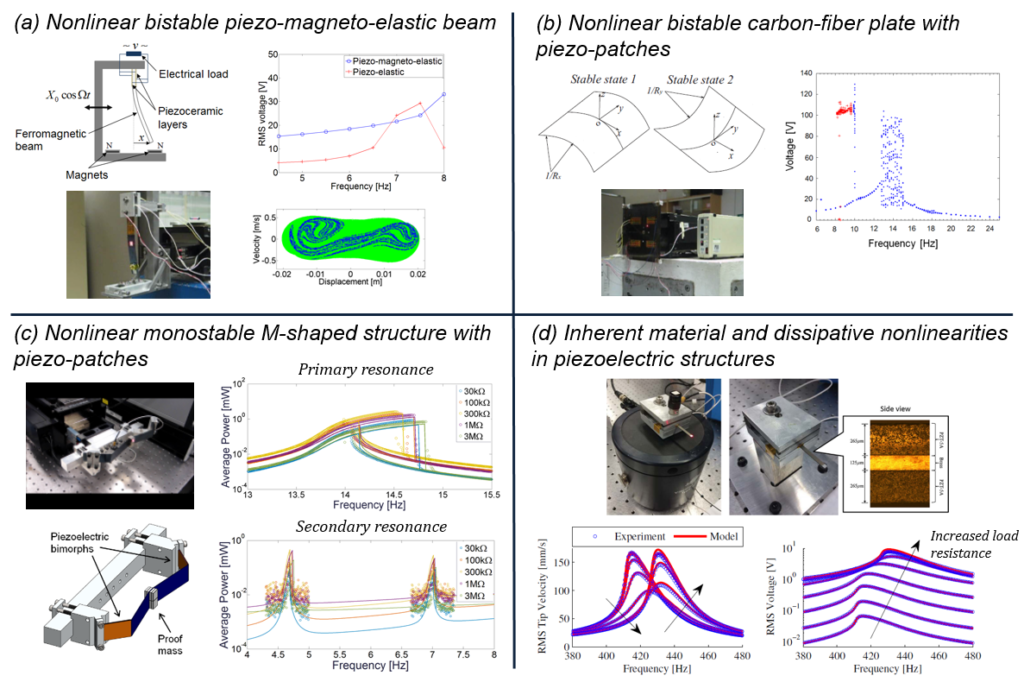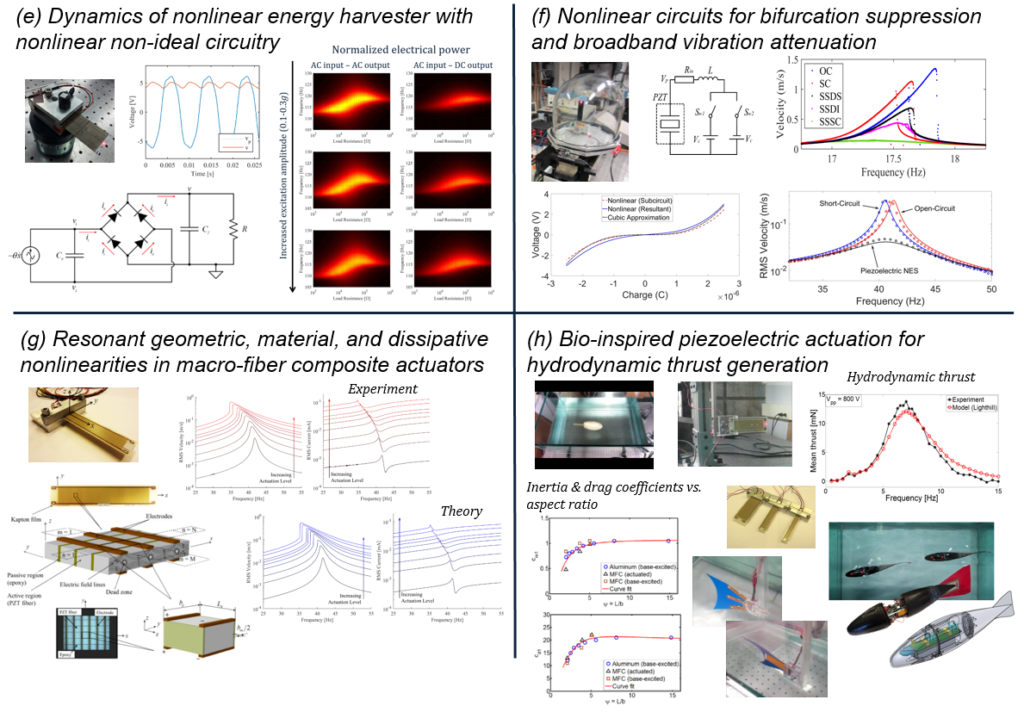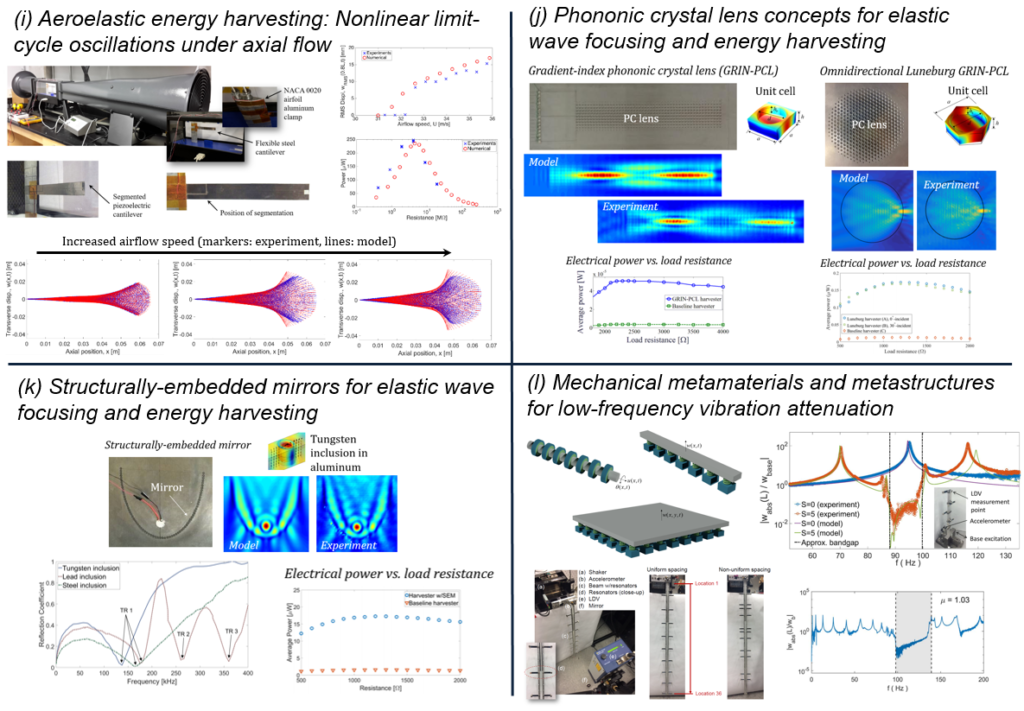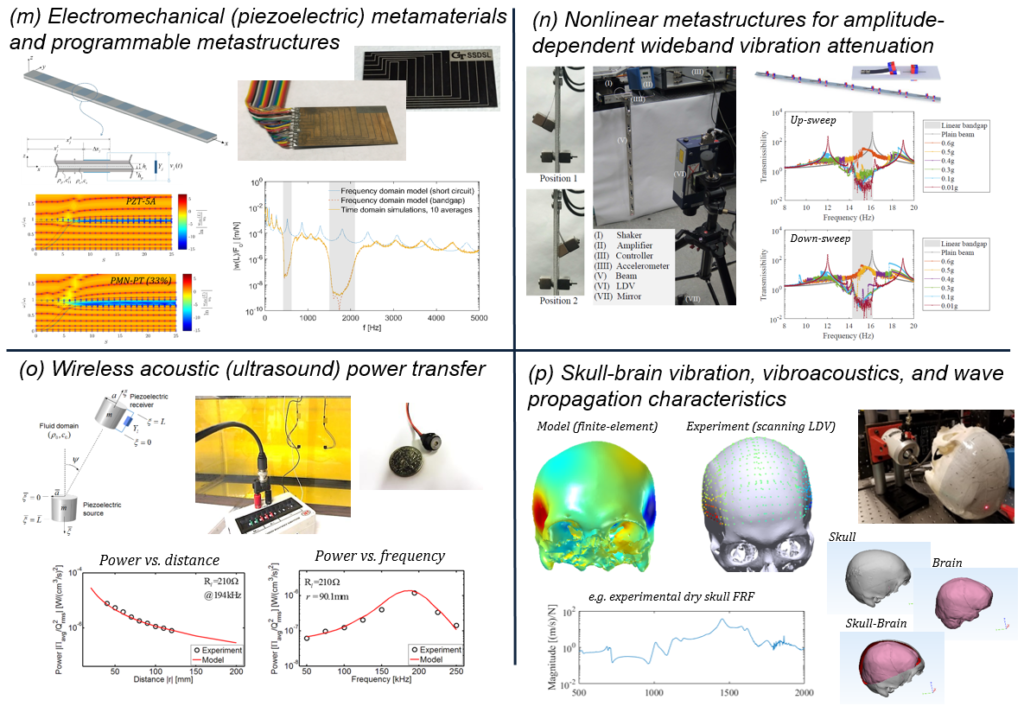In SSDSL, our theoretical and experimental research interests are centered around the intersection of smart structures and dynamical systems to address cutting-edge research problems including low-power electricity generation via energy harvesting (e.g. from vibration, elastic/acoustic waves, air/water flow, etc.), bio-inspired nonlinear actuation and hydrodynamic thrust generation using flexible piezoelectric materials, vibration attenuation in flexible linear/nonlinear structures via passive and active metamaterials, wireless acoustic (ultrasonic) power and data transfer, phononic crystal-based elastic/acoustic wave guiding, leveraging structural dynamics and wave propagation (e.g. of human skull-brain system) in biomedical engineering, among others. Some examples of recent and ongoing research are described below. Overall, SSDSL research aims to understand, control, and leverage vibration and wave phenomena across geometric scales, disciplines, and applications.
One of the primary research interests in SSDSL is exploiting nonlinear dynamic phenomena in emerging fields. For instance, nonlinear electromechanical structures are leveraged for frequency bandwidth enhancement, nonlinear frequency-up conversion, and modal interactions in vibration energy harvesting (a-c). The goal in the field of vibration energy harvesting is to convert ambient vibrations into electricity toward enabling self-powered electronic components for applications such as wireless sensor networks, wearable electronics, and ultimately the Internet of Things. Nonlinear energy harvesters offer orders of magnitude larger frequency bandwidth as compared to their linear counterparts, yielding efficient energy conversion over a wide range of ambient vibration frequencies. Beyond prototype design, development, and fabrication, SSDSL research on the subject aims to understand and exploit complex dynamic interactions of intentionally designed (a-c) and inherently present material and dissipative nonlinearities (d) through rigorous experiments and high-fidelity modeling. The combination of mechanical (e.g. material) nonlinearities with nonlinear non-ideal components (e.g. diodes) in the electrical domain is required to obtain a stable electrical signal in order to charge a storage component, yielding complex dynamics and amplitude dependent behavior as modeled and analyzed (e) in SSDSL. As another critical research topic, piezoelectric shunt damping of flexible nonlinear structures via nonlinear circuits for bifurcation suppression and novel nonlinear electrical shunt circuits (e.g. piezoelectric nonlinear energy sink) for wideband vibration attenuation are explored (f). Flexible piezoelectric structures, such as macro-fiber composites with interdigitated electrodes, strike a balance between the actuation force and deformation capabilities, resulting in substantial geometric, material, and dissipative nonlinearities, which are modeled and analyzed (g). Such piezoelectric materials are employed in SSDSL as internally actuated bio-inspired aquatic locomotion platforms to imitate fish-like swimming (h) and to understand fluid-structure interaction of complex fin motions.
The combination of mechanical (e.g. material) nonlinearities with nonlinear non-ideal components (e.g. diodes) in the electrical domain is required to obtain a stable electrical signal in order to charge a storage component, yielding complex dynamics and amplitude dependent behavior as modeled and analyzed (e) in SSDSL. As another critical research topic, piezoelectric shunt damping of flexible nonlinear structures via nonlinear circuits for bifurcation suppression and novel nonlinear electrical shunt circuits (e.g. piezoelectric nonlinear energy sink) for wideband vibration attenuation are explored (f). Flexible piezoelectric structures, such as macro-fiber composites with interdigitated electrodes, strike a balance between the actuation force and deformation capabilities, resulting in substantial geometric, material, and dissipative nonlinearities, which are modeled and analyzed (g). Such piezoelectric materials are employed in SSDSL as internally actuated bio-inspired aquatic locomotion platforms to imitate fish-like swimming (h) and to understand fluid-structure interaction of complex fin motions. The transformation of airflow into aeroelastic vibrations of piezoelectric structures in high wind areas is another way of low-power electricity generation at small geometric scales for powering small electronic components. The resulting vibrations due to fluid-structure interaction are typically more complicated than simple standing wave mode shapes, rendering electrode segmentation to avoid charge cancellation a more involved task (i). On another topic, structure-borne propagating elastic waves are explored as a source of energy. Specifically, phononic crystal lens (j) and structurally-embedded mirror (k) concepts are explored numerically and experimentally to spatially focus and thereby enhance the harvested electrical energy by an order of magnitude. Metamaterial concepts are also explored in SSDSL for low-frequency bandgap formation and vibration attenuation via locally resonant metastructures (l), leading to a general theoretical modeling and analysis framework for 1D and 2D structures as well as experimental validations.
The transformation of airflow into aeroelastic vibrations of piezoelectric structures in high wind areas is another way of low-power electricity generation at small geometric scales for powering small electronic components. The resulting vibrations due to fluid-structure interaction are typically more complicated than simple standing wave mode shapes, rendering electrode segmentation to avoid charge cancellation a more involved task (i). On another topic, structure-borne propagating elastic waves are explored as a source of energy. Specifically, phononic crystal lens (j) and structurally-embedded mirror (k) concepts are explored numerically and experimentally to spatially focus and thereby enhance the harvested electrical energy by an order of magnitude. Metamaterial concepts are also explored in SSDSL for low-frequency bandgap formation and vibration attenuation via locally resonant metastructures (l), leading to a general theoretical modeling and analysis framework for 1D and 2D structures as well as experimental validations. The electromechanical counterparts of metamaterials and metastructures that leverage piezoelectricity offer a plethora of opportunities since the dynamics of piezoelectric unit cells (i.e. building blocks) can be tailored on demand via analog and/or digital circuitry (m). Such programmable piezoelectric metamaterials and metastructures are researched in SSDSL for altering vibration attenuation and wave propagation characteristics of structures. Designed nonlinearities – as in (a-c) – are of interest in metastructures as well. Bistable unit cells exhibit linear intrawell, nonlinear intrawell, and nonlinear interwell oscillations for locally resonant, softening, and chaotic dynamics, respectively, yielding ultra-broadband behavior especially for moderate to large amplitude excitations (n). Another research topic explores wireless acoustic power transfer (from a piezoelectric transmitter to a receiver) for deep-implanted and inaccessible wireless electronic components and sensors (o). As a last example, skull-brain vibration/vibroacoustics and their combination with high frequency wave propagation are explored (p) to improve trans-skull wave transmission and focusing.
The electromechanical counterparts of metamaterials and metastructures that leverage piezoelectricity offer a plethora of opportunities since the dynamics of piezoelectric unit cells (i.e. building blocks) can be tailored on demand via analog and/or digital circuitry (m). Such programmable piezoelectric metamaterials and metastructures are researched in SSDSL for altering vibration attenuation and wave propagation characteristics of structures. Designed nonlinearities – as in (a-c) – are of interest in metastructures as well. Bistable unit cells exhibit linear intrawell, nonlinear intrawell, and nonlinear interwell oscillations for locally resonant, softening, and chaotic dynamics, respectively, yielding ultra-broadband behavior especially for moderate to large amplitude excitations (n). Another research topic explores wireless acoustic power transfer (from a piezoelectric transmitter to a receiver) for deep-implanted and inaccessible wireless electronic components and sensors (o). As a last example, skull-brain vibration/vibroacoustics and their combination with high frequency wave propagation are explored (p) to improve trans-skull wave transmission and focusing. Our research has been funded by various federal agencies (NSF, AFOSR, NIST, etc.) and government labs (e.g. Sandia NL), as well as industrial contracts, among others.
Our research has been funded by various federal agencies (NSF, AFOSR, NIST, etc.) and government labs (e.g. Sandia NL), as well as industrial contracts, among others.